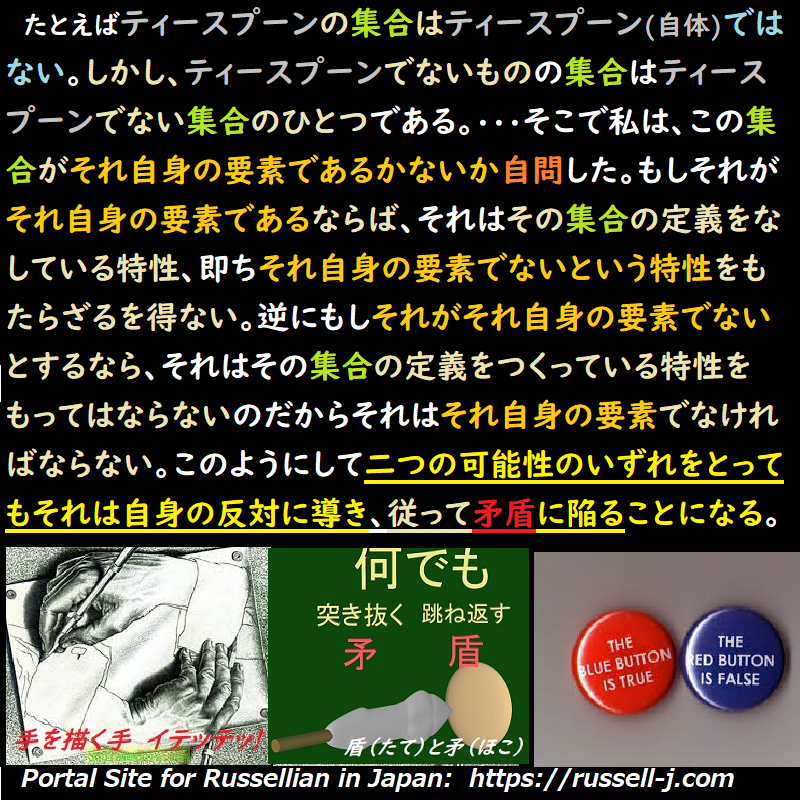(発展の方向の)不愉快な側面は、疑いもなくとても不愉快なものであった。(即ち、)学派の区別なく,全ての論理学者が、アリストテレスの時代以来ずっと受け入れてきた前提から、(いろいろな)矛盾が演繹され(導出され)、何かがまちがっていることを示しているがしかしどそれらの問題をどうやって正したらよいかについては何も示していないように思われた。私が享受しつつあった論理的蜜月(logical honeymoon)を終わらせたのは、1901年の春に、そういう矛盾のびとつを私が発見したことであった(注:これが論理学史上有名な「ラッセルのパラドクス」の発見)。私はこの不幸をホワイトヘッドに伝えた彼は「喜びに満ち自信が溢れる朝は再び来らず(never glad confident morning again 喜ばしい確固とした朝は二度と来ないのだ!)」という句を引いて私をなぐさめようとしたが、無駄であった。 私がこの矛盾に導かれたのは、最大の基数(cardinal number)は存在しないというカントールの証明を吟味することによってであった。私は、無邪気にも、世界にある全てのものの数(総数)は最大の数であるに違いないと信じ、カントールの証明をこの数に適用し、どういう結果が出てくるかを見ようとした。このプロセス(手順/処置)は、非常に奇妙な集合の考察へと私を導いた。それまで正しいと思っていたやり方で考えを進めてゆくと、一つの集合が、ある時は自己自身(その集合自身)の要素(成員/メンバー)でありかつ(同時に)自己自身の要素でないようにと思われた。たとえばティースプーン(紅茶やコーヒー用のスプーン)の集合は、ティースプーン(自体)ではない。しかしティースプーンでないものの集合は、ティースプーンでない集合(one)のひとつである。さらにこのように否定的なものではないところの例も存在すると思われた。たとえば、全ての集合の集合は、ひとつの集合である。ところでカントールの議論(論証)を適用していって、私は、「自己自身の要素でない諸集合」を考えるに至ったが、これらの集合もまたひとつの集合を形づくらなければならないと思われた。そこで私は、この集合がそれ自身の要素であるかないか、自問した。もしそれがそれ自身の要素であるならば、それは、その集合の定義をなしている特性、すなわち、それ自身の要素でないという特性をもたらざるを得ない。逆にもしそれがそれ自身の要素でないとするなら、それはその集合の定義をつくっている特性をもってはならないのだから、それは、それ自身の要素でなければならない。このようにして、二つの可能性のいずれをとっても、それは自身の反対に導き、従って矛盾に陥ることになる。
Chapter 7: Principia Mathematica: Philosophical Aspects, n.3 The unpleasant aspect was indubitably very unpleasant. It appeared that, from premisses which all logicians of no matter what school had accepted ever since the time of Aristotle, contradictions could be deduced, showing that something was amiss but giving no indication as to how matters were to be put right. It was the discovery of one such contradiction, in the spring of 1901 , that put an end to the logical honeymoon that I had been enjoying. I communicated the misfortune to Whitehead, who failed to console me by quoting, ‘never glad confident morning again’. I was led to this contradiction by considering Cantor’s proof that there is no greatest cardinal number. I thought, in my innocence, that the number of all the things there are in the world must be the greatest possible number, and I applied his proof to this number to see what would happen. This process led me to the consideration of a very peculiar class. Thinking along the lines which had hitherto seemed adequate, it seemed to me that a class sometimes is, and sometimes is not, a member of itself. The class of teaspoons, for example, is not another teaspoon, but the class of things that are not teaspoons, is one of the things that are not teaspoons. There seemed to be instances which are not negative: for example, the class of all classes is a class. The application of Cantor’s argument led me to consider the classes that are not members of themselves; and these, it seemed, must form a class. I asked myself whether this class is a member of itself or not. If it is a member of itself, it must possess the defining property of the class, which is to be not a member of itself. If it is not a member of itself, it must not possess the defining property of the class, and therefore must be a member of itself. Thus each alternative leads to its opposite and there is a contradiction.
Source: My Philosophical Development, chap. 7:1959.
More info.:https://russell-j.com/beginner/BR_MPD_07-030.HTM

